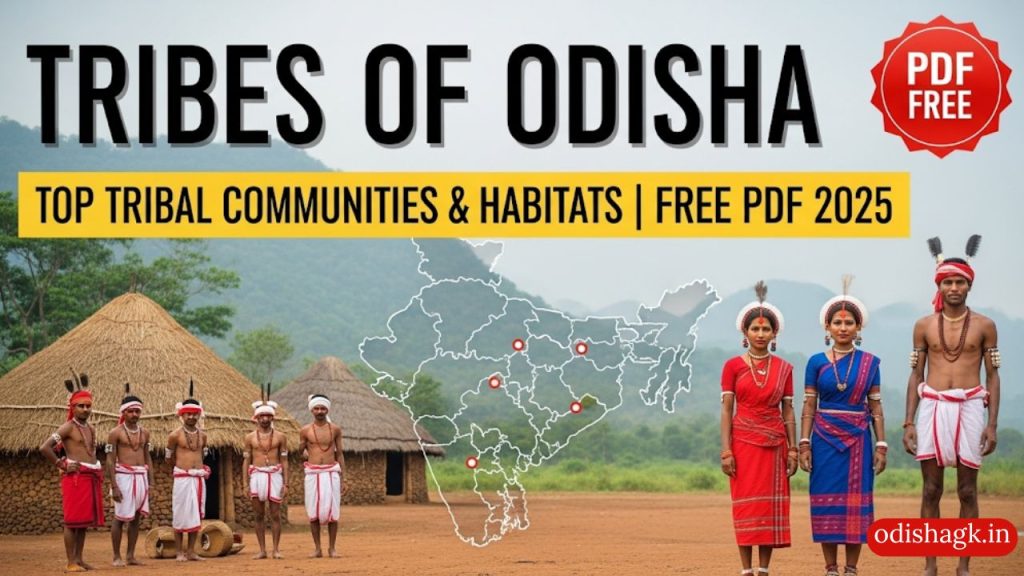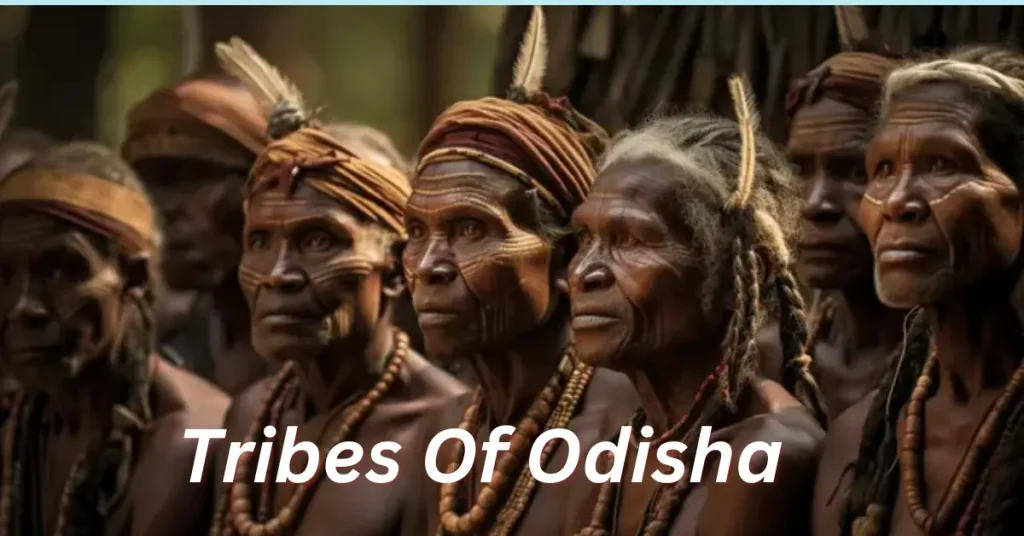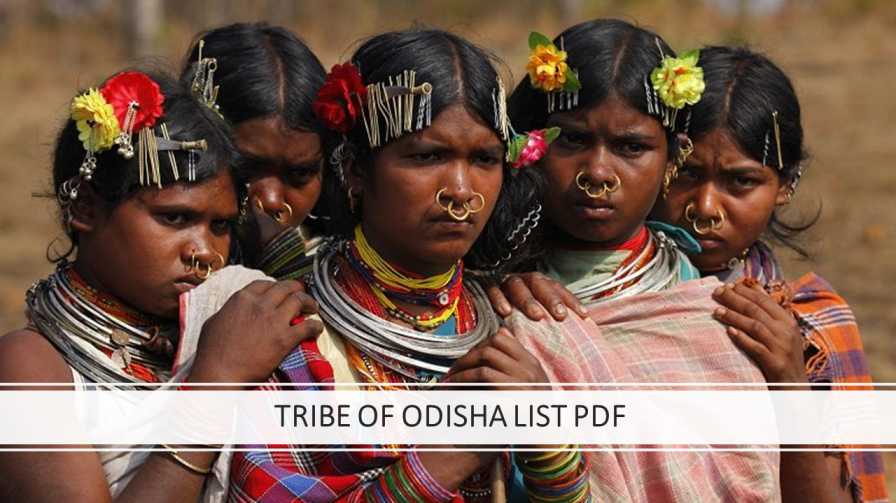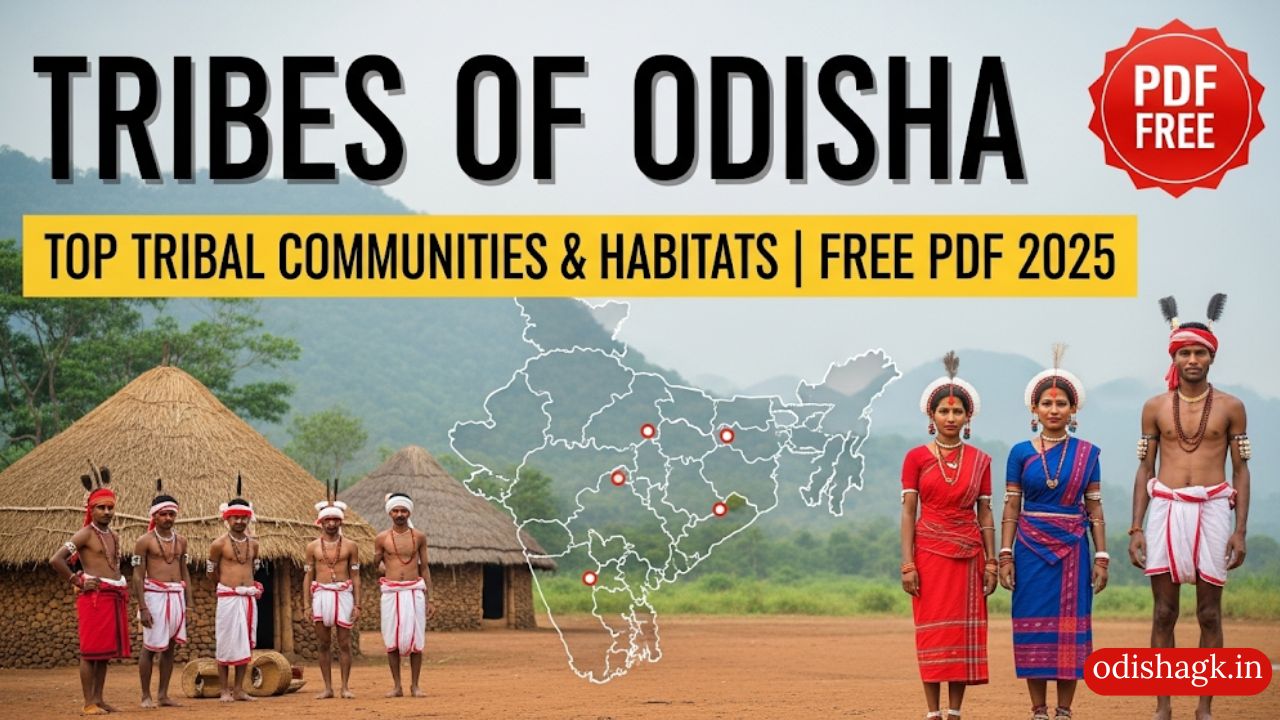In this post we share a most important topic Tribes of odisha that help to your upcoming Competitive Exam

Odisha holds a unique and significant position on India’s ethnographic map due to its exceptionally diverse tribal population. It is home to 62 different tribal communities, including 13 Particularly Vulnerable Tribal Groups (PVTGs), which is the highest number among Indian states.
As per the 2011 Census, Scheduled Tribes constitute 22.85% of Odisha’s total population, making it the third-largest ST population numerically in India. These communities are primarily concentrated in the hilly and forested regions of the state, particularly in the northern and southern parts. More than half of the total tribal population is found in districts like Koraput (undivided), Sundargarh, and Mayurbhanj.
Each tribal community in Odisha possesses a distinct identity, expressed through their social organization, language, customs, rituals, festivals, dress, ornaments, art, and crafts. They represent various stages of socio-economic development, from those who maintain a secluded and traditional way of life to those who have largely assimilated into the mainstream.
Here’s a detailed look at some of the main tribal communities and their habitats:
Main Tribal Communities and Their Habitats in Odisha
- Kondh (Kandha / Khond)
- Population: The largest tribal group in Odisha.
- Habitat: Primarily in the hilly and jungle regions of Kandhamal and adjoining districts like Rayagada, Koraput, Balangir, Boudh, and Kalahandi.
- Characteristics: Known for their strong connection to nature and animistic beliefs. They have sub-groups like Dongria Kondh (known for cultivating steep slopes in the Niyamgiri hills of Rayagada and Kalahandi) and Kutia Kondh. They speak Kui and Kuvi languages (Dravidian family). Traditionally involved in shifting cultivation (Podu) and collecting forest produce.
- Santal (Santhal)
- Population: The second-largest tribal community in Odisha.
- Habitat: Concentrated mainly in Mayurbhanj district, also found in Keonjhar, Jajpur, Balasore, Bhadrak, Sambalpur, Jharsuguda, Sonepur, Deogarh, Dhenkanal, Angul, and Sundargarh.
- Characteristics: Known for their vibrant culture, love for music and dance. They speak Santhali, an Austro-Asiatic language with its own script, Ol Chiki. Historically known as great fighters.
- Saora (Sora / Sabara / Savar)
- Population: Significant population, one of the most ancient tribes mentioned in Hindu epics.
- Habitat: Primarily found in Gajapati (especially Paralakhemundi), Rayagada, and undivided Ganjam and Puri districts.
- Characteristics: Known for their unique shamanic culture, traditional artwork (Saura paintings), and a strong spiritual connection to their ancestors. They speak Sora, a Munda language, for which a script has also been developed. Often carry an axe as a traditional tool. The Lanjia Saora are a Particularly Vulnerable Tribal Group (PVTG).
- Ho
- Population: A large tribal group.
- Habitat: Inhabit Mayurbhanj, Keonjhar, Jajpur, Balasore, Bhadrak, Sambalpur, Jharsuguda, Sonepur, Deogarh, Dhenkanal, Angul, Sundergarh, and Kandhamal districts.
- Characteristics: Speak the Ho language, part of the Austro-Asiatic family. Primarily engaged in agriculture.
- Munda
- Population: Substantial population.
- Habitat: Mainly in the northern districts like Mayurbhanj, Sundargarh, Keonjhar, and Sambalpur.
- Characteristics: Speak Mundari language. Known for their community spirit and traditional village organization.
- Oraon (Uraon / Kurukh)
- Population: A significant tribal group.
- Habitat: Found mainly in Sundargarh and Sambalpur districts.
- Characteristics: Considered one of the more progressive and developed tribes. They speak Kurukh, a Dravidian language. Many have adopted modern occupations, including tea plantation work.
- Gond
- Population: A widespread tribal group found across central India.
- Habitat: In Odisha, they are found in Koraput, Kalahandi, Bolangir, Sambalpur, and Sundargarh.
- Characteristics: Known as a warrior tribe. They engage in agriculture, forest produce collection, and cottage industries. They speak Gondi, a Dravidian language.
- Bhuiya (Bhuinya / Pauri Bhuyan)
- Population: A prominent tribal group.
- Habitat: Primarily found in Keonjhar, Sundargarh, Sambalpur, Dhenkanal, Angul, Balangir, and Koraput districts.
- Characteristics: Known for their distinct social customs and village leadership roles. The Paudi Bhuyan are a PVTG, often residing in remote hilly areas.
- Paroja (Parja)
- Population: One of the largely populated tribes in the southern region.
- Habitat: Mostly found in Koraput, Semiliguda, Pottangi, Laxmipur, Lamataput, Nandapur, Dashmantpur, Jeypore, Boipariguda, and Kundra blocks of Koraput district.
- Characteristics: Their name possibly derives from ‘Praja’ meaning common citizens. They have strong artistic talents, expressed in their Dhemsa and Dungdunga dances. Primarily agriculturists.
- Gadaba
- Population: An ancient tribe, part of the Munda group.
- Habitat: Largely in Koraput district (Lamataput, Similiguda, Pottangi blocks).
- Characteristics: Known for their colorful attire, particularly the women’s traditional saree made of Kerenga fiber (Kereng). They are famous for their Dhemsa dance. They speak Gutab and Desia dialects.
Particularly Vulnerable Tribal Groups (PVTGs) in Odisha (13 Communities)
Odisha has the highest number of PVTGs in India. These groups are characterized by a pre-agricultural level of technology, a stagnant or declining population, extremely low literacy rates, and a subsistence level of economy.
The 13 PVTGs in Odisha are:
- Bonda:
- Habitat: Isolated hill regions of Malkangiri district (Khairput Block), specifically in the Bonda Hills.
- Characteristics: Known as ‘the Naked People’ due to their traditional attire. They maintain a relatively secluded life, speaking Remo language (Austro-Asiatic).
- Birhor:
- Habitat: Small pockets in Mayurbhanj and Keonjhar districts.
- Characteristics: Traditionally nomadic or semi-nomadic, known for rope-making from Chop (Bauhinia vahlii) bark and hunting.
- Didayi:
- Habitat: Along the Machhkund River in Malkangiri district.
- Characteristics: Known for their clean, well-painted houses and traditional mixed occupations. They speak Didayi language.
- Dongria Kondh:
- Habitat: Niyamgiri hills in Rayagada and Kalahandi districts.
- Characteristics: Known for their strong reverence for Niyamgiri hill (their deity) and their unique agricultural practices on steep slopes. They are a sub-group of the Kondhs.
- Juang:
- Habitat: Primarily in Keonjhar and Dhenkanal districts.
- Characteristics: One of the oldest tribal communities, historically known for leaf-dresses (though largely abandoned now).
- Kharia (Hill Kharia):
- Habitat: Mayurbhanj and Sundargarh districts.
- Characteristics: Traditional hunter-gatherers, collecting forest produce like honey and wild roots.
- Kutia Kondh:
- Habitat: Kandhamal and Rayagada districts.
- Characteristics: Another PVTG sub-group of the Kondhs, known for their distinctive facial tattoos.
- Lanjia Saora:
- Habitat: Gajapati and Rayagada districts.
- Characteristics: A sub-group of the Saora, recognized by the long hair bun worn by men. Known for their intricate wall paintings (Idital).
- Lodha:
- Habitat: Mayurbhanj and Balasore districts.
- Characteristics: Traditionally forest dwellers, often facing challenges of displacement and livelihood.
- Mankidia:
- Habitat: Small groups in Mayurbhanj and Keonjhar districts.
- Characteristics: Nomadic or semi-nomadic, primarily engaged in monkey hunting and rope-making.
- Paudi Bhuyan:
- Habitat: Sundargarh and Keonjhar districts (particularly the Pauri Bhuyan hills).
- Characteristics: A sub-group of the Bhuyan, known for shifting cultivation and living in isolated hill tracts.
- Saora (PVTG status given to certain Saora groups):
- Certain Saora sub-groups are also identified as PVTGs due to their extreme vulnerability.
- Chuktia Bhunjia:
- Habitat: Nuapada and Kalahandi districts.
- Characteristics: A small group known for their distinct culture and dependence on forest resources.
General Characteristics of Odisha’s Tribal Communities:
- Linguistic Diversity: Tribes in Odisha speak languages belonging to three major linguistic families:
- Austro-Asiatic (Munda/Kolarian): Santhali, Mundari, Ho, Juang, Saora, Gadaba, Bonda, Birhor, Didayi.
- Dravidian: Kui, Kuvi (Kondh), Gondi, Koya, Kurukh (Oraon).
- Indo-Aryan: Desia (spoken by some tribes who have adopted Odia dialects).
- Economic Activities: Traditionally reliant on forest resources, shifting cultivation (Podu), hunting, gathering, and primitive agriculture. Many have gradually transitioned to settled agriculture, wage labor, and other modern occupations.
- Social Organization: Mostly endogamous (marrying within the community), patrilocal (wife moves to husband’s village), and patrilineal (descent through the father). They often have strong clan/sib organizations.
- Cultural Richness: Known for their vibrant festivals (e.g., Chaita Parab, Karma), traditional dances (e.g., Dhemsa, Chhau), music, folklores, and distinctive art and craft forms (e.g., Saura paintings, Dhokra metal craft, bamboo weaving).
- Close Relationship with Nature: Many tribes consider animals, trees, and specific forest patches as sacred, reflecting a deep respect for their environment.

Important tribes Of Odisha PDF Download
| Name of the Tribes | District |
| Kandha | Koraput, Malakanagiri, Nabaragngapur, Phulbani, Boudh, Ganjam and Gajapati |
| Kolha | Keonjhar, Koraput, Gajapati and Sundargarh |
| Saura | Koraput, Malkanagiri, Ganjam and Rayagada |
| Santal | Mayurbhanj, Balasore and Keonjhar |
| Praja | Kalahandi, Nuapada, Koraput, Rayagada and Nabarangapur |
| Ganda | Jharsuguda, Kalahandi, Nuapada, Boudh, Balangir, Koraput and Rayagada |
| Bonda | Koraput, Rayagada, Malkangiri |
| Oraon | Sundergarh, Jharsuguda, Deogarh and Rayagada |
| Juang | Angul, Jajpur, Keonjhar and Dhenkanal |
| Bhumiji | Jajpur, Mayurbhanj, Keonjhar, Sundargarh, Dhenkanal |
| Bhuyan | Sundergarh, Keonjhar, Mayurbhanj, Angul |
| Koya | Nabarangapur, Malkanagiri |

Other Major Tribe of odisha are
| Baiga | |
| Banjara | Banjari |
| Bathudi | Bathuri |
| Bhottada | Dhotada, Bhotra, Bhatra, Bhattara, Bhotora, Bhatara |
| Bhuiya | Bhuyan, Paudi Bhuyan |
| Bhumia | |
| Bhumij | Teli Bhumij, Haladipokhria Bhumij, Haladi Pokharia Bhumija, Desi Bhumij, Desia Bhumij, Tamaria Bhumij |
| Bhunjia | Chuktia Bhunjia |
| Binjhal | Binjhwar |
| Binjhia | Binjhoa |
| Birhor | |
| Bondo | Bonda Paroja, Banda Paroja |
| Chenchu | |
| Dal | |
| Desua Bhumij | |
| Dharua | Dhuruba, Dhurva |
| Didayi | Didai Paroja, Didai |
| Gadaba | Bodo Gadaba, Gutob Gadaba, Kapu Gadaba, Ollara Gadaba, Parenga Gadaba, Sano Gadaba |
| Gandia | |
| Ghara | |
| Gond | Rajgond, Maria Gond, Dhur Gond, Gondo |
| Ho | |
| Holva | |
| Jatapu | |
| Juang | |
| Kandha Gauda | |
| Kawar | Kanwar |
| Kharia | Kharian, Berga Kharia, Dhelki Kharia, Dudh Kharia, Erenga Kharia, Munda Kharia, Oraon Kharia, Khadia, Pahari Kharia (Hill Kharia) |
| Kharwar | |
| Khond | Kond, Kandha, Nanguli Kandha, Sitha Kandha, Kondh, Kui, Buda Kondh, Bura Kandha, Desia Kandha, Dungaria Kondh, Kutia Kandha, Kandha Gauda, Muli Kondh, Malua Kondh, Pengo Kandha, Raja Kondh, Raj Khond |
| Kisan | Nagesar, Nagesia |
| Kol | |
| Kolah Loharas | Kol Loharas |
| Kolha | |
| Koli | Malhar |
| Kondadora | |
| Kora | Khaira, Khayara |
| Korua | |
| Kotia | |
| Koya | Gumba Koya, Koitur Koya, Kamar Koya, Musara Koya |
| Kulis | |
| Lodha | Nodh, Nodha, Lodh |
| Madia | |
| Mahali | |
| Mankidi | |
| Mankirdia | Mankria, Mankidi |
| Matya | Matia |
| Mirdhas | Kuda, Koda |
| Munda | Munda Lohara, Munda Mahalis, Nagabanshi Munda, Oriya Munda |
| Mundari | |
| Omanatya | Omanatyo, Amanatya |
| Oraon | Dhangar, Uran |
| Parenga | |
| Paroja | Parja, Bodo Paroja, Barong Jhodia Paroja, Chhelia Paroja, Jhodia Paroja, Konda Paroja, Paraja, Ponga Paroja, Sodia Paroja, Sano Paroja, Solia Paroja |
| Pentia | |
| Rajuar | |
| Santal | |
| Shabar | Lodha |
| Sounti | |
| Tharua | Tharua Bindhani |

